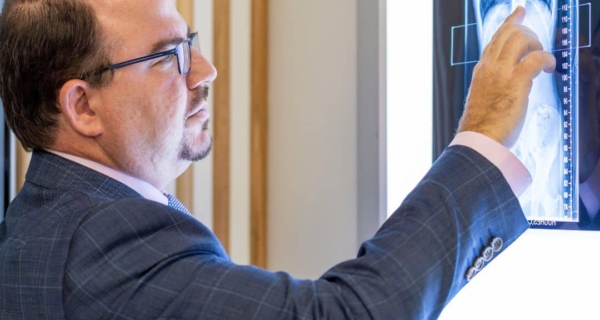We’ve long known that specific scoliosis rehabilitation and exercise programs are an essential part of a complete approach to patient care. Research* has shown that these specialised programs can help to stop small scoliosis curves from progressing, and in the case of larger curves, can be used as an important adjunct to better bracing results.
There are many different rehabilitation approaches that have been used in the conservative management of scoliosis. In the chiropractic world the most well known are CBP (Chiropractic Biophysics) and the Clear Institute, which involve spinal traction, exercise and adjustments. The most recognised physical therapy methods are SEAS (Scientific Exercise Approach to Scoliosis) from Italy and the Schroth Method from Germany.
We use a physiotherapeutic scoliosis specific exercise (PSSE) program called ScoliBalance. You might have heard the term ‘ScoliBalance’ before from a patient or seminar, but what does it mean?
The ScoliBalance Approach

The ScoliBalance concept was created by Dr. Jeb McAviney (Chiropractor) drawing on his clinical experience treating scoliosis using a combination of Chiropractic Biophysics, SEAS and Schroth techniques.
The ScoliBalance program combines the most relevant practices and principles in physical therapy, chiropractic and exercise rehabilitation for a 3D approach to managing scoliosis, tailored to each individual patient according to their curve type, symptoms and treatment goals. It is delivered in accordance with the SOSORT^ guidelines(1).
ScoliBalance builds on the foundation of other PSSE programs focusing on aspects that are most effective and achievable for patients to learn and implement. ScoliBalance Providers are trained to teach the patient a scoliosis specific 3D posture correction (ScoliCorrection) that positions the patient’s spine in the straightest possible alignment. From there the patient is taught specific ScoliExercises whereby the aim is to hold their ScoliCorrections while they perform the exercises.
As the patient becomes more familiar with the program they are taught to integrate the ScoliCorrection into their activities of daily living (1). In doing so, the body is trained to subconsciously hold the ScoliCorrection helping to reduce or stabilise the scoliosis curve. The program also often uses a ScoliRoll (for scoliosis) or Denneroll (for hyperkyphosis) to enhance the correction to the spine and posture.
How can ScoliBalance help?
ScoliBalance can be used as part of a complete approach to care for patients with scoliosis or kyphosis. It may assist to:
- Slow down/stop curve progression
- Aid in the reduction of flexible scoliosis curves
- Improve coronal and sagittal balance
- Complement brace wear to help maintain the correction achieved with bracing
- Improve muscular balance and spinal flecibility
- Improve posture and body appearance
- Reduce pain
- Improve standing balance and reduce fall risk in older adults.
For smaller curves: In the case of small adolescent idiopathic curves of less than 20 degrees, ScoliBalance may help to stop the curve from progressing and improve posture and body cosmetics.
For non-progressive curves: ScoliBalance may also be used without bracing when a curve is non-progressive, for example in older adolescent or young adult cases where the focus is to help improve posture, manage pain and stabilise the spine.
In combination with bracing: The principles of the ScoliCorrection used in ScoliBalance are consistent with the corrective approach used in the design of ScoliCare’s custom 3D scoliosis brace. When ScoliBalance and this brace are used in conjunction, research (3) shows that muscle endurance and spinal flexibility can be improved during treatment. Although not recommended, in cases where patients are wearing a different brace, the ScoliBalance program may help to counter the negative effects of other braces such as stiffening of the spine and muscle weakness.
Adult cases: By focusing on improvements in spinal balance, ScoliBalance is effective at reducing back pain in the majority of scoliosis cases. If the curve is flexible, it may also be possible to achieve cosmetic improvement of the body.
Degenerative cases: While ScoliBalance is very helpful in pain management, it may also aid in slowing the progression of a degenerative curve. However where degenerative progression is present, an adult custom 3D brace should be recommended.
ScoliBalance is delivered by experienced professionals.
In all ScoliCare Clinics worldwide, ScoliBalance treatment is delivered by Scoliosis Rehabilitation Therapists who have specialised training in the ScoliBalance system.
ScoliBalance is also available outside of ScoliCare Clinics through a select group of healthcare professionals who have been trained and certified in the ScoliBalance program.
You can learn more about ScoliBalance by visiting the ScoliBalance page.
*Supporting research
- (1) 2016 SOSORT guidelines: Orthopaedic and rehabilitation treatment of idiopathic scoliosis during growth, Negrini et al, 2018. Paper here
- Active self-correction and task-oriented exercises reduce spinal deformity and improve quality of life in subjects with mild adolescent idiopathic scoliosis. Results of a randomised controlled trial. Monticone et al, 2014 Paper here
- Scoliosis-specific exercises can reduce the progression of severe curves in adult idiopathic scoliosis: a long-term cohort study. Negrini et al, 2015 Paper here
- The effects of exercise therapy on adolescent idiopathic scoliosis: An overview of systematic review and meta-analyses. Zhor et al, 2021 Paper here
- The natural history of adolescent idiopathic scoliosis, Weinstein, 2019 Paper here
- Why do we treat adolescent idiopathic scoliosis? What we want to obtain and avoid for our patients. SOSORT 2005 Consensus paper, Negrini et al, 2006. Paper here
(2) The approach incorporates recommendations by the international guidelines provided by SOSORT including active self-correction in 3D, stabilisation of the corrected posture, integration into activities of daily living and patient education. 2016 SOSORT guidelines: Orthopaedic and rehabilitation treatment of idiopathic scoliosis during growth, Negrini et al, 2018. Paper here
(3) Improvement of trunk muscle endurance in Adolescent Idiopathic Scoliosis (AIS) patients undergoing ScoliBrace and Scientific Exercise Approach to Scoliosis (SEAS) treatment, SOSORT Book of Abstracts, SOSORT Lyon 2017. Paper here
Abbreviations
**Barcelona Scoliosis Physical Therapy School (BSPTS)
^ SOSORT is the International Society of Scoliosis Orthopaedic and Rehabilitation Treatment. (1) Negrini et al, 2018.


